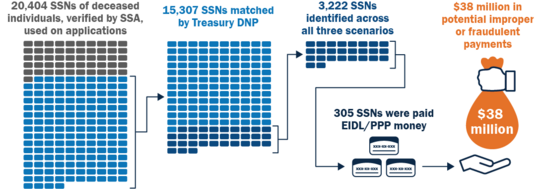We're following up on our findings,
and keeping you in the loop
You might remember the Fraud Alert we released (scroll down for a refresher) where we found 69,000 questionable SSNs used to obtain $5.4 billion in pandemic funds. Now, our data scientists have narrowed these numbers even more. We now know that SSNs of deceased individuals were submitted on applications totaling $38 million in potentially improper or fraudulent PPP and EIDL loans.
And here's a visual breakdown:

We needed to find out if those people were deceased at the time of filing or after the application was submitted. To do this, we asked the Social Security Administration to verify that the SSNs in our Fraud Alert belonged to deceased individuals - and we got dates of death for most of them from the Department of Treasury’s Do Not Pay (DNP) system.
Our data scientists dug further and found that thousands of the deceased individuals' SSNs were used on EIDL and PPP applications submitted:
-
After their date of death
-
Before and after their date of death, or
-
Before the date of death but paid after the date of death.
You can learn more about the methodology for these findings, how DNP works, and the lessons we've learned through this process here.
Read the original Fraud Alert below 
We've identified $5.4 billion in potentially fraudulent pandemic loans.
We took a closer look at questionable Social Security Numbers used in applications for pandemic loans. Here's what we found.
We found over 69,000 questionable Social Security Numbers in applications for the SBA's Economic Injury Disaster Loan (EIDL) and Paycheck Protection Program (PPP) programs, totaling $5.4 billion in potentially fraudulent pandemic loans and grants.
Our Pandemic Analytics Center of Excellence analyzed information from 33 million EIDL and PPP applications to identify questionable SSNs that may have been invalid or not assigned, and then worked with the Social Security Administration to verify the numbers.
Read the overview of how we found the potential identity fraud, along with our recommendations for next steps, here on our website.
Here's a visual breakdown of the numbers:

|

